| |
|
It's
a Bird, It's a Plane, It's...Superbug! |
|
Boeing F/A-18E Super Hornet,
BuNo. 165665 ("NJ-173")
Moffett Federal Airfield, California
September 13, 2003
|
|
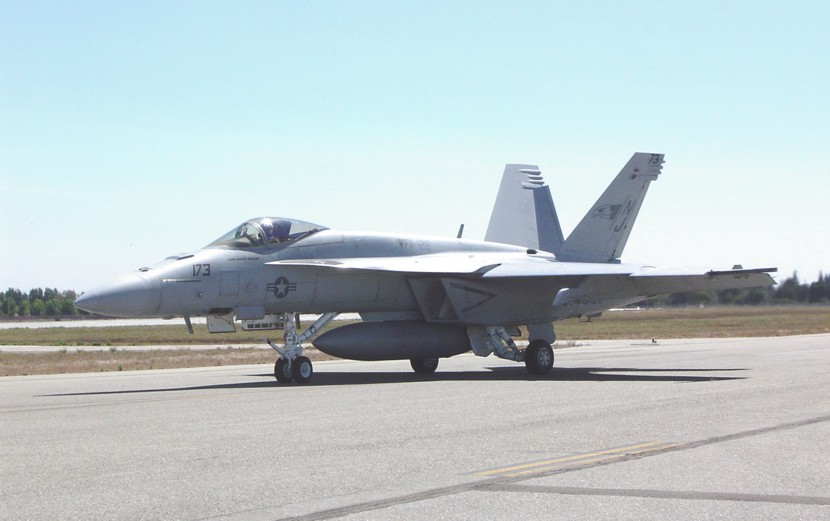
| Mountain View,
California. Among the many interesting things
showcased during this year's AirExpo at Moffett Federal Airfield
was the airplane that represents the future of tactical naval aviation.
The F/A-18E Super Hornet (known, somewhat irreverently, in certain
circles as the "Superbug") is currently
being introduced into the fleet along with her two-seat sister, the
F/A-18F, and has already seen a fair amount of combat. On
Saturday morning, shyly tucked away on the Moffett ramp behind a
restored P-51 and two F-16Cs from Hill AFB, a pristine example of
the type could be seen patiently waiting for its chance to introduce
itself to the crowd.
This
particular Super Hornet is F/A-18E BuNo. 165665 (the 19th
E-model built), wearing the stylized eagle's head that is
characteristic of aircraft belonging to Strike Fighter Squadron One
Twenty Two, based at Naval Air Station Lemoore in central California. It bears the side number "173," unusual for a
fleet squadron embarked aboard a carrier but typical in the case of
training aircraft. VFA-122 "Flying Eagles" is the
Navy's Super Hornet RAG (the "Replacement Air Group," a
technically obsolete but still popular term), responsible for
initiating new aircrews into the mysteries of the Superbug.
It's a big job, as virtually the entire F-14 community is slated to
convert to the two-seat F/A-18F in the next few years, while a number
of C-model Hornet squadrons will convert to F/A-18Es. That process has already
begun, and as of this writing two squadrons have already converted
to E-models (VFA-115 and VFA-14), and two more to F-models (VFA-41
and VFA-102). Some of these squadrons have already seen combat
in their new mounts over Afghanistan and Iraq. |
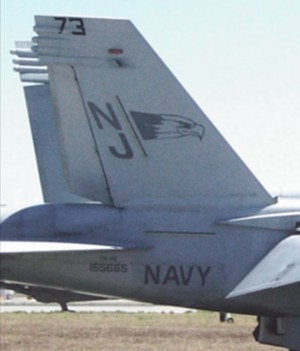 |

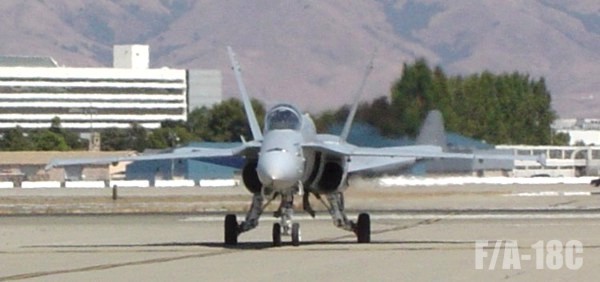
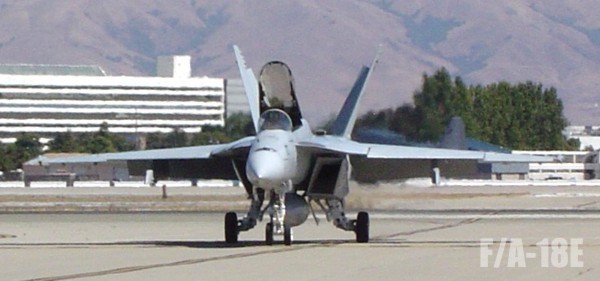 |
The first
thing that strikes you about the Superbug is its size. The
F/A-18E is about 25% larger than the original C-model, and adds
about six feet of overall wingspan. To the left are two
Hornets viewed from roughly the same angle. On the top
is one of VFA-125's F/A-18Cs, which also happened to be visiting the Bay Area for
AirExpo; on the bottom is the F/A-18E.
Whereas the nose and fuselage
dominates the front profile of the C-model, the E-model has
noticeably broader
"shoulders." The larger leading-edge root extensions
and squared-off air inlets on the Super Hornet give the impression
of a bulkier aircraft. The Super Hornet also seems to have
larger control surfaces; flaps, slats, rudders, horizontal
stabilizers -- everything moves when the pilot does his
control checks. |

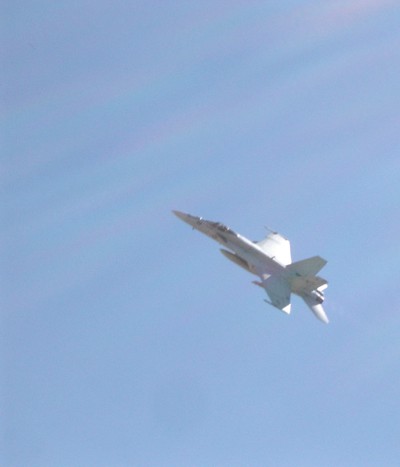 |
In the air,
the Superbug makes a definite impression. Its planform is
strikingly large, almost on the order of an F-14 (its overall length
is only two feet shorter, although what seems to make the real
difference are the larger wingroots). During the flight
demonstration, the Super Hornet joined a beautifully-restored Hawker Sea
Fury in a salute to naval aviation old and new; as you can see
above, the younger fighter dwarfs its elder.
Reportedly, the Super Hornet's bulkier
airframe causes its top speed to suffer when compared to the C-model,
although there is nothing to suggest this to the casual observer observing both types in flight --
the jet appears to defy
both inertia and gravity. The F/A-18E's new twin General
Electric F414-GE-400 engines generate an enormous 22,000 lbs. of
thrust apiece, which is considerably more thrust than is available
in the older (but admittedly lighter) Hornet models.
Technical minutia aside, watching the
Superbug in flight is a positively visceral experience.
During a barely-subsonic high-speed pass, the F/A-18E hurtles along
whisper-silent, looking for all the world like a rounded black
arrowhead. Then, just before it passes, you hear the tearing
screech of those jet engines assault the ground, and then the jet flashes
overhead, pulling up and to the right...and in its wake there's that
boom, a thousand pounds of sonic ordnance bellowing deep in your
chest. Then you blink and the Superbug's gone, having disappeared
somewhere into
the heavens, with only a momentary wingflash to mark its departure.
|
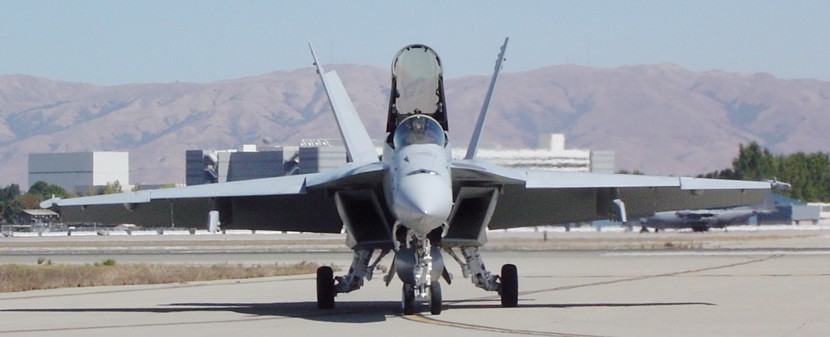
| The single most
obvious external feature distinguishing the Superbug
from earlier A- and C-models is, of course, the pair of large, trapezoidal
inlets that replace the small rounded jet intakes of the classic
Hornets. Those, combined with
the bigger wing roots on either side of the fuselage, give the
F/A-18E the hooded look of a cobra. Despite the E-model's
size, it is said to have a radar cross-section that is only a
fraction of that of the earlier Hornets.
On the right, the demonstration pilot
takes a bow. BuNo. 165665 is personalized for VFA-122's
operations officer, a very experienced driver of the type who,
reportedly, has since been promoted. VFA-122's
instructor crews are the Navy's Superbug experts, and their
experience is highly sought after in the line F/A-18E/F squadrons that are
currently joining the fleet. -RJL.
All photographs were taken by the
author using a 3.2-megapixel Sony Cybershot DSC-P72 pocket digital
camera.
|
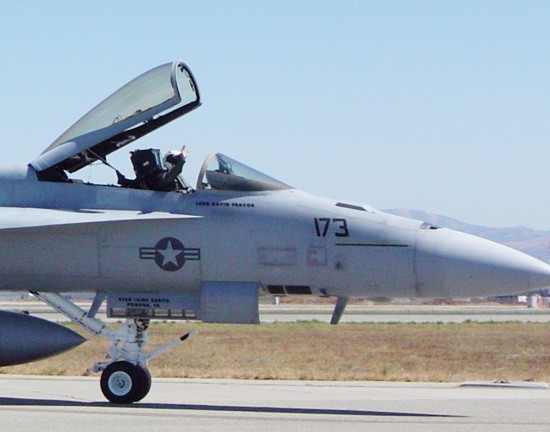 |
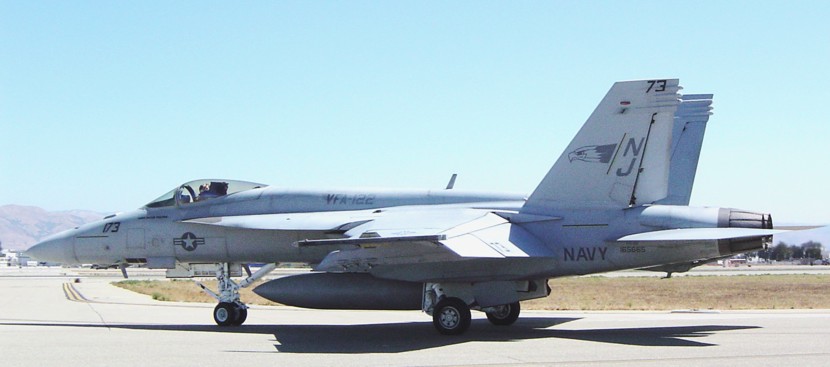

My impression of a VFA-41 "Black
Aces" two-seat Superbug, done with CorelPHOTO-PAINT last
Christmas. Yeah, it's not a photo and it's not even an F/A-18E, but
I thought I'd include it anyway. The Black Aces have since taken
their F-models to war with CVW-11 aboard USS Nimitz (CVN 68).
|
|